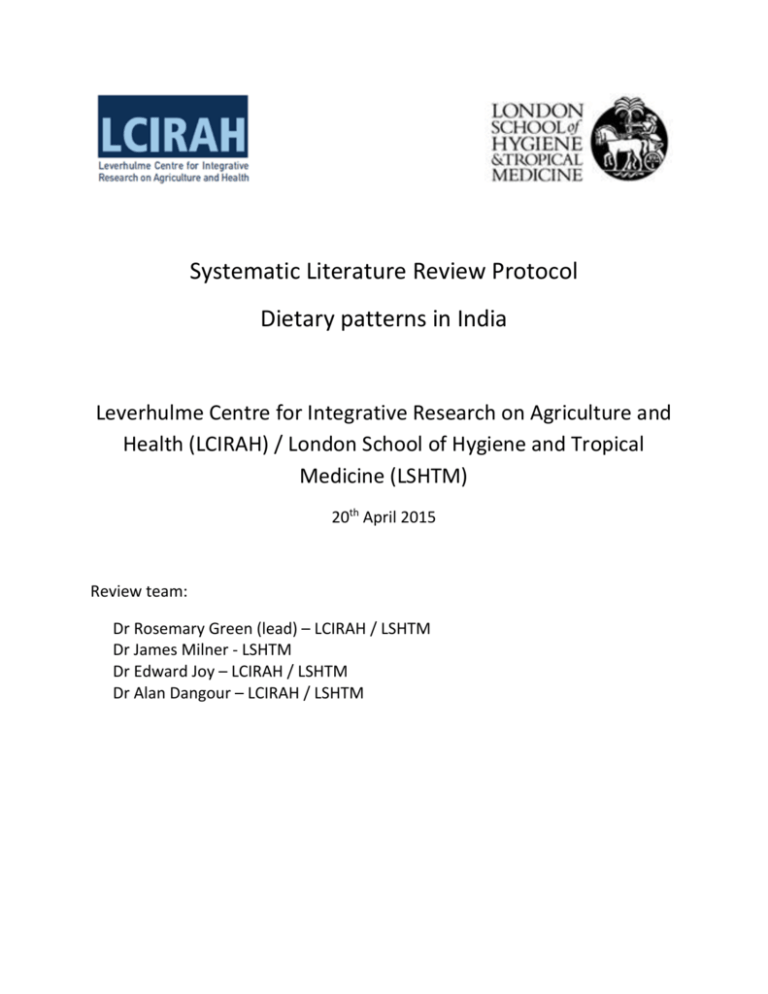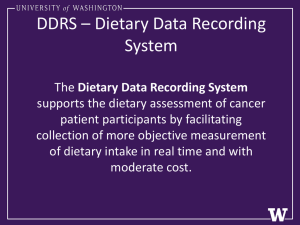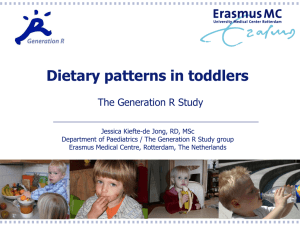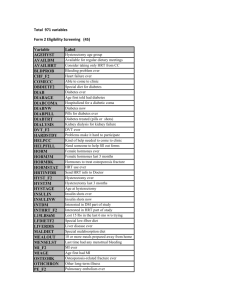Dietary Patterns in India: systematic review protocol
advertisement

Systematic Literature Review Protocol Dietary patterns in India Leverhulme Centre for Integrative Research on Agriculture and Health (LCIRAH) / London School of Hygiene and Tropical Medicine (LSHTM) 20th April 2015 Review team: Dr Rosemary Green (lead) – LCIRAH / LSHTM Dr James Milner - LSHTM Dr Edward Joy – LCIRAH / LSHTM Dr Alan Dangour – LCIRAH / LSHTM Dietary Patterns in India: systematic review protocol 1. Research Questions What dietary patterns in India have been identified by previous studies using modelling techniques? Do the patterns identified differ according to factors such as region, year, gender or method of study? 2. Background India is often cited as an example of a country undergoing a ‘nutrition transition’, where undernutrition remains prevalent but where there are also increasing rates of diseases associated with overweight and obesity [1]. India has a high prevalence of obesity and diabetes but has not yet adopted a truly ‘Westernised’ diet [2]. Instead, diets are culturally diverse and strongly related to local food availability. In addition, India covers a huge geographical area comprising many different agricultural practices and cultural approaches to food as well as large socioeconomic inequalities. When exploring the health and environmental impacts of Indian diets, it therefore makes little sense to describe an average population diet. A number of previous studies have used data from dietary surveys to explore various dietary patterns in India and to characterise the consumers of these patterns [3]. However, there are several different methods for estimating dietary patterns, such as Principal Component Analysis (PCA), factor analysis (FA) and various types of cluster analysis including Latent Class Analysis (LCA) [4]. The dietary data used to define the patterns also come from diverse sources and represent different sub-populations and time periods. No study has yet reviewed the existing literature on dietary patterns in India to determine whether common patterns have been identified across studies, and whether differences in dietary patterns correspond to the methods used to define the patterns, the populations being studied, or other factors related to study design. This review aims to bridge this gap by searching for common patterns and sources of difference in the existing literature. A further aim of the study is to identify the most appropriate method for defining dietary patterns for a future study of the health and environmental impacts of different dietary patterns in India. 3. Aims Primary aim: To systematically review studies that have modelled dietary patterns in India Secondary aims: To examine differences in the patterns identified according to the methods used To identify whether studies of different regions, years and populations have defined different dietary patterns To identify the most useful method for defining dietary patterns for a new study of diets in India 4. Search strategy A number of search terms will be used across multiple databases in order to identify studies which have used modelling techniques to identify distinct dietary patterns in India. Search terms will include combinations of “diet*”, “pattern*” and “India*” with specific terms including “food”, “intake”, “principal component*”, “pca”, “factor*”, “fa”, “cluster*”, “latent class*” and “mixture model*”. This list will be expanded if additional search terms are identified during the review process. A final list will be defined prior to running the full search. Multi-database searching will be employed, across the following databases: EMBASE EThoS Global Health IndMED MEDLINE PubMed Scopus ISI Web of Science Other sources of literature will also be searched in order to identify additional studies from the non-peer reviewed literature. These will include: Google Google Scholar FAO World Bank IFPRI Published peer-reviewed studies will be included in the review, as will grey literature such as dissertations, conference proceedings, reports and other non-peer reviewed studies. The inclusion of the latter will assist with any identification of publication bias (which would be expected to be particularly severe in the peer-reviewed literature) and will also facilitate the inclusion of governmentcommissioned studies. Grey literature will be subject to the same quality assessment as peer-reviewed studies (see 5. below). Reviews will be hand-searched for other relevant references, as will the reference lists of included studies. All located abstracts will then be examined based on the inclusion and exclusion criteria defined below. Inclusion criteria: Studies containing an estimation of distinct dietary patterns (at least 2 patterns defined) Studies including dietary data from India Studies of humans Original scientific research papers (not review articles) Studies of children or adults (not including infant feeding studies) Studies using food consumption data from dietary surveys Studies containing modelling of dietary patterns (not individual foods or nutrients) Studies published in English, Hindi, Urdu or Punjabi Papers which meet the inclusion criteria will be obtained from the relevant database or journal website, from the LSHTM library, from a linked library such as Senate House or from the British Library if no other copies are available. 5. Study quality Study quality will be assessed using an index containing a number of criteria. Studies will be scored on each item in the index according to whether the required information is present. For sensitivity analysis, poorer quality papers will be removed from any statistical analysis in order to determine whether they affect the results. Study quality index: Description of what foods included in each group? (1 for yes, 0 for no) Clear description of models used? (1 for yes, 0 for no) Description of how individual patterns were identified? (1 for yes, 0 for no) Description of what geographical area(s) of the country are covered? (1 for yes. 0 for no) Description of sectors of the population represented? (1 for yes, 0 for no) Description of what year(s) data were collected? (1 for yes, 0 for no) Data nationally representative? (1 for yes, 0 for no) Statistical test used to quantify robustness of solution? (1 for yes, 0 for no) 6. Data extraction An Excel database will be compiled containing all relevant information from the included studies. This database will include fields describing the study authors, year, journal or publication format, geographical area(s), year(s) data were collected, specific population(s) studied, statistical methods, whether the study meets each of the quality criteria, food groups used, number and description of the dietary patterns identified, characteristics of consumers of each dietary pattern (if available) and any other relevant information about the study. The review team leader (Green) will conduct the search using the databases listed above, and this search will be replicated by another review team member (Milner) in order to check for inconsistencies. Two members of the review team (Green and Milner) will extract the data from the studies and input them into the Excel database. Cross-checking of data extraction will be performed on 10% of the included studies in order to confirm that identical data have been extracted. A third member of the team will also be involved in cross-checking data extraction. 7. Potential sources of bias Publication bias – this will be assessed by comparing the effect sizes reported by peer-reviewed and non peer-reviewed studies that are judged to be of good quality. English-language bias – this will be assessed by comparing the effect sizes reported by English language and non-English language studies. Multiple publication – if the results of a study have been published in more than one journal (or have been included in a review article as well as a report of a single study) any duplicate results will be removed. Methodological issues – included studies will have used a range of methods to estimate dietary patterns, although most are likely to have used variations on factor analysis or cluster analysis. Studies will be differentiated by the methods they have used (see data analysis section below for more details). 8. Data analysis The data collected are expected to be highly heterogeneous in nature, so we will not attempt a quantitative synthesis of the results. Instead we will summarise the results of the review in tables or graphs according to the methods used for dietary patterns estimation and the number and type of patterns identified. We will also produce data visualisations showing where studies have identified similar patterns and where these differ according to study design and other factors. 9. Conclusions This review will assess the evidence on dietary patterns in India, and will produce summary tables and graphics showing the similarities and differences in the patterns found according to populations included and study designs. The results will inform policy discussions concerning what current diets in India look like, and will also provide valuable inputs for future research assessing the health and environmental impacts of these diets. 10. References 1. 2. 3. 4. Atkin, D., Trade, tastes, and nutrition in India. American Economic Review, 2013. 103(5): p. 1629-1663. Daniel, C.R., et al., A cross-sectional investigation of regional patterns of diet and cardiometabolic risk in India. Nutrition Journal, 2011. 10. Moeller, S.J., et al., Dietary patterns: challenges and opportunities in dietary patterns research. Journal of the American Dietetic Association, 2006. 107(7): p. 1233-1239. Newby, P.K. and K.L. Tucker, Empirically derived eating patterns using factor or cluster analysis: a review. Nutrition Reviews, 2004. 62(5): p. 177-203.








